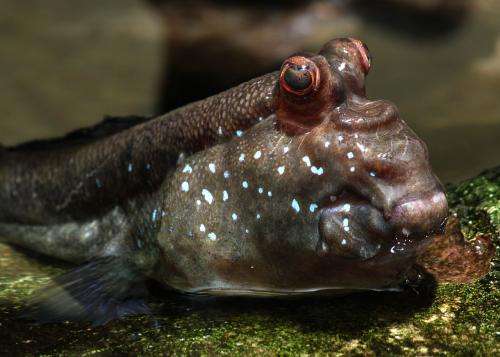March 18, 2015 report
Mudskipper fish may offer clues about development of tongue in land animals

Bob Yirka
news contributor

(Â鶹ÒùÔº)—A team of researchers with Universiteit Antwerpen in Belgium has uncovered the mechanism by which mudskippers, a type of fish that feed on land, obtains its food. In their paper published in Proceedings of the Royal Society B the team describes how they filmed the fish using a variety of techniques to determine how it caught and swallowed prey.
Scientists are reasonably certain that land animals came to exist only after they crawled out of the sea and adapted to a radically different environment. One of those ways they had to change was in how they caught and swallowed their food. For fish, it is a pretty straightforward process, they suck in water that holds tiny prey and swallow the whole works, and then squirt out the filtered water afterwards. Land animals, on the other hand, have developed tongues that not only help many animals capture prey, but guide the food to the back of the throat to aid in swallowing. In this new study, the researchers looked to learn more about this evolutionary process by studying the mudskipper—its method of eating seems to offer a glimpse of what may have occurred in the development of tongues.
Mudskippers are not very good at capturing prey in the water—more often, they waddle their way onto dry land and pounce on food with their mouths, and then swallow it. Other fish that venture onto land have to return to the sea to swallow, but not the mudskipper, this is because, the team found out, it uses water held in its mouth as a sort of tongue.
The team set up several specimens in a lab and then filmed them capturing prey using high speed and x-ray cameras. In reviewing the video, the team discovered that the fish actually grabs a mouthful of water before making its way onto land; then when it spots something edible, such as a shrimp, it lunges with its head, mouth landing on the target. Some of the water in the mouth is expelled, engulfing the food, but then it is sucked right back in, carrying the food morsel with it. But that was not the end of the story, the fish then manipulated the water in its mouth to position the food bit in a way as to allow for swallowing—in effect it was using the water as other animals use their flesh tongues. This, the team reports, might be how it was that those first critters to crawl from the sea, captured and ate prey, swallowed it and then developed real tongues as they were likely more efficient, and did not require a return trip to the sea for refreshing mouthfuls of water.
Written for you by our author —this article is the result of careful human work. We rely on readers like you to keep independent science journalism alive. If this reporting matters to you, please consider a (especially monthly). You'll get an ad-free account as a thank-you.
More information: A fish that uses its hydrodynamic tongue to feed on land, Proceedings of the Royal Society B ,
Abstract
To capture and swallow food on land, a sticky tongue supported by the hyoid and gill arch skeleton has evolved in land vertebrates from aquatic ancestors that used mouth-cavity-expanding actions of the hyoid to suck food into the mouth. However, the evolutionary pathway bridging this drastic shift in feeding mechanism and associated hyoid motions remains unknown. Modern fish that feed on land may help to unravel the physical constraints and biomechanical solutions that led to terrestrialization of fish-feeding systems. Here, we show that the mudskipper emerges onto land with its mouth cavity filled with water, which it uses as a protruding and retracting 'hydrodynamic tongue' during the initial capture and subsequent intra-oral transport of food. Our analyses link this hydrodynamic action of the intra-oral water to a sequence of compressive and expansive cranial motions that diverge from the general pattern known for suction feeding in fishes. However, the hyoid motion pattern showed a remarkable resemblance to newts during tongue prehension. Consequently, although alternative scenarios cannot be excluded, hydrodynamic tongue usage may be a transitional step onto which the evolution of adhesive mucosa and intrinsic lingual muscles can be added to gain further independence from water for terrestrial foraging.
Journal information: Proceedings of the Royal Society B
© 2015 Â鶹ÒùÔº


















